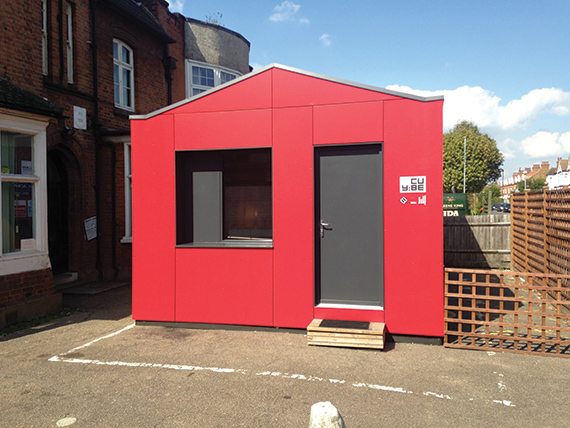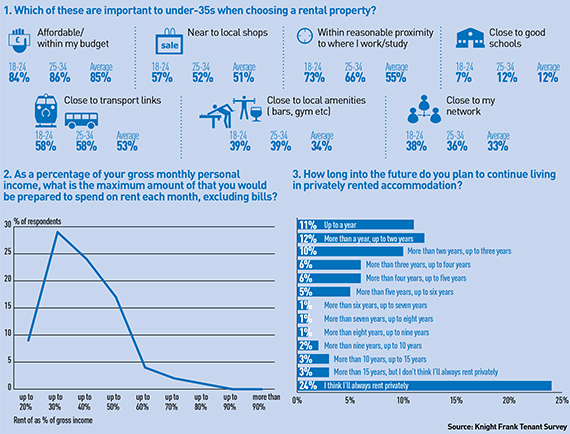One of the biggest challenges I have faced in my investigation into affordable rental options has been sourcing locations and convincing owners to let me stay for my trial period.
For various reasons I have taken my fair share of rejections; from being deemed too corporate for a commune in south London to being turned away at the last minute from a converted shipping container due to sanitation issues – theirs, not mine!
Twitter has therefore become a useful tool for sourcing alternative options and this is where I stumbled across the Y-Cube – the YMCA’s pioneering initiative to provide an affordable housing solution for those moving on from hostels.
With plans for their first site in Merton, south London, to be completed in 2015, the YMCA kindly agreed to let me trial their prototype, in a car park outside their Wimbledon HQ, for a weekend. As I could stay only for a few days – rather than heeding the Lowe Cost Living rule of three weeks per property – you get two write-ups for the price of one this week as I also report on my stay in a former halfway house in Hammersmith.
Thinking inside the box
First up, the Y-Cube. The man behind the concept is the YMCA’s South West director of housing, Andy Redfearn. He came up with the idea three years ago as an alternative to the PRS.
Aware of the pitfalls of poor-quality shared accommodation managed by private landlords, the YMCA teamed up with architect Rogers Stirk Harbour and Partners to develop a self-contained one-bedroom flat on a shoestring.
Costing a mere £30,000 to construct, the Y-Cubes are factory built in Derbyshire before being flat packed down to London, where they can be put up and taken down in a matter of days.
Due to their temporary status, they are the perfect fit for optimising short-term space, such as brownfield or stalled development sites. To maintain affordability, the plan is to rent out the Y-cubes for £140 a week, 65% of market rent, meaning they pay for themselves within 15 years.
Arriving at YMCA’s base in Wimbledon, SW19, I was taken to an empty car park where, slap bang in the middle, sat what can only be described as an inflated Monopoly hotel. Wrapped in vibrant red cladding, the Y-Cube is certainly an eye-catching piece of architecture. They can be stacked on top of each other up to eight storeys to save space and act as temporary mini blocks.
My cube – and home for the weekend – is cleverly laid out to look pretty spacious given the size of the unit.
At just 26 sq m the Y-Cube falls 12 sq m below the London Housing Design Guide space standard. But as it is classed as “semi-permanent”, it bypasses these guidelines.
A combined living area and fully fitted kitchen leads to a separate bedroom, which has room for a large double bed, storage units and an adjoining en-suite; it feels anything but cramped.
Functional, stylish and, most importantly, affordable. And for the first time in three months I have my own house all to myself.
The latest Knight Frank tenant survey, published last week, reports that more than half (54%) of 18-24 year olds said they would be happy to live in a studio flat if doing so made the rent more affordable in return for a central location. And my experiences fully support these findings.
I think schemes such as the Y-Cube can provide a realistic solution to the lack of affordable rental options in central London. But they need to go a step further. They need to become permanent structures.
This transition can only start to be achieved by allowing developers to build a larger number of studios and one-bed flats in central locations, while reassessing the minimum space standards dictated by the London Housing Design Guide.
Not only would this make commercial sense for developers, but it would also see far more affordable options coming to the market.
As for the Y-Cube, the green light has been given for 36 units to be erected in Mitcham, with the site expected to be completed next year.
The £100 renting option
After saying goodbye to the Y-Cube, I found myself in Hammersmith for my fourth rotation, this time as a caretaker for a former halfway house for young offenders.
The charity that ran the house had relocated and, while the building was empty, had employed specialist live-in security firm Ambika to keep watch.
It was not the most glamorous spot to bunk down for three weeks but it was by far the most affordable I have come across on my travels at just £100 a month all in. This is basically unheard of within zone 2.
But there was a catch: between the hours of 8pm and 8am, one resident had to be present in the property at all times. This was enforced with regular check-ups to ensure caretakers were not making any late night trips out. After spending an entire week in an office, the last thing on your mind is getting back to your room by 8pm on a Friday night!
Unlike the property guardian scheme I had trialled for my first rotation back in the summer, I was not crammed into the building like a squashed sardine, forced to share a shower with 18 other residents and an increasing rat population.
Ambika ensures that buildings are looked after properly and securely as well as avoiding overcrowding. This time I had the comfort of my very own floor, complete with kitchen, bathroom and living room with just one other housemate occupying the floor below.
But it wasn’t the most homely of existences. The building’s decrepit interiors were littered with signs of its previous inhabitants; from punch marks dotted all across the living room walls, to signs around the building warning those who continued to disobey the charity’s anti-drug policy that they would face immediate expulsion.
But following my previous stint on a houseboat I was quite happy to have some hot water and electricity past 9pm, so, to some extent, my surroundings were of little consequence.
I shared the building with Ross, a rather eccentric filmmaker who has been living with Ambika for the past five years. Spending many of his evenings editing his work, he finds that committing to certain nights a week fits well with his work schedule and sees it as an add-on to his job.
He also doesn’t have a problem with the 24 hours’ notice caretakers can be given, in the worst-case scenario, if they are to be moved on. When you are paying such a nominal rent, the occupiers have to accept a level of flexibility in return.
This model may not be for everyone, but if you’re prepared to rough it, it is one of the most effective ways to save money in London.
And, as Knight Frank’s Tenant Survey shows, since more than a third of Londoners currently renting are planning to stay in the rented sector for between a further two and 15 years, having low-cost options has to be a good thing.
Last week I moved into my penultimate location, living in a housing co-operative with three generations of one family on the South Bank.
The transition from living with one person to a packed house, complete with animals and teenagers, has been quite dramatic but I am very much enjoying it. I will report back soon.
Tenant trends
The idea that rented accommodation is purely a short-term stopgap among those saving to buy a house is challenged by the findings of Knight Frank’s Tenant Survey. The survey, which canvassed the opinions of more than 3,500 renters across the country, shows that 24% never expect to own their own home, while more than a third choose to rent because it suits their lifestyle or because they do not want a mortgage.
Our Tenant Survey, the largest survey of its kind conducted to date, highlights how and where tenants want to live, and how much they want to pay for accommodation.
In fact affordability is the main theme to emerge from the survey, with 85% highlighting this as a key factor in their decision, compared with just over half who choose proximity to work and transport. The survey also highlights how priorities change depending on age, with younger renters very concerned about how close they are to their workplace (chart 1). This underlines the trend we are seeing for demand for rented accommodation in city centres across the UK among young professionals.
It is the youngest and the oldest renters who want to be closest to transport links, with 36% of 18 to 24 year olds and 55% of those aged over 75 saying they would prefer to live within 250 metres of their nearest bus stop or train station. But 78% of respondents want to live within 1 km, or around a 12-minute walk, from their nearest transport link, rising to 91% in London.
When we drilled down into the results from tenants, especially younger renters, we found an increasing proportion willing to live in smaller units in order to secure an affordable rent in a central location. Some 42% of Londoners said they would choose a studio flat in order to live in a central location if it made the rent more affordable, compared with a national average of 36%. But if we look at Londoners aged 18-24, the proportion rises to 54%.
When it comes to rent, across the country, the average maximum of gross pay tenants are willing to pay is 40%. But there are stark regional variations. While 44% of those in the North of England expect to pay up to 30% of their gross income on rent, this falls to 31% in London. In fact, one in ten Londoners is prepared to pay more than half their gross income on rent, underlining the relative expense of the current choice of rental accommodation in the capital – something which Tim Lowe, a Knight Frank graduate, has been exploring in these pages over the past few months.
The data on how much time tenants expect to stay in the private rented sector is also telling, with nearly a quarter saying they do not expect to leave rented accommodation. This is relatively evenly spread among low to medium income brackets, with 21% of those earning between £40,000 and £45,000 a year saying they never expect to buy a home.















